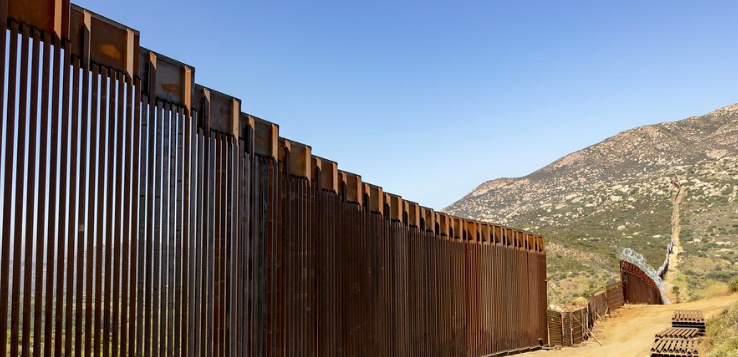The US and Mexico need a border, just not the one currently delineated
By Greg Custer
A Cold War is brewing with China. The U.S.-Mexico-Central American humanitarian crisis continues unabated. The pandemic has laid bare the soft, exposed underbelly of globalization, an over-dependence on events time-zones distant.
How can the U.S. rebound with sharper focus on regional alliances? A good place to start can be a pivot, south toward our relationship and border with Mexico.
In this world of shifting alliances and loyalties, the U.S.-Mexico border should be understood and probed with renewed determination. This line of sand and river embodies the inevitable reckoning of our binational, ingrained bonds.
A border “fix” could dramatically reduce America’s tenuous overseas dependencies and put Mexico on a development path toward addressing the grinding poverty across its southernmost states, the focus of President López Obrador’s administration.
Both nations want the same things: peace, security, and international trade. An innovative response to the border quagmire could become the economic engine and social justice solution driving our binational, mid-21st century connectiveness. Especially at a time when China-American relations are imploding, the border needs a new future. In this spirit, is it time to move it?
The U.S. and Mexico do need a border, just not the one currently delineated. Borders exist for good reasons, but this border is not working. Could the border be moved? With a pen stroke, yes. Let us suppose for the moment it could happen.
By most measures of binational cooperation, the current demarcation running through mega-urban centers is broken. Environmental violations, crime, smuggling, and the migration crisis make it impossible to expect the current megacity clusters to remain viable. The existing international border treaty (re-negotiated in 1970, modifying the 1840-1850s treaties) reaffirms the notion that international borders can be moved by the will of governments.
The efficacy of a newly drawn border lies in its isolation, completely detached from any developed towns or settlements. The new border would bypass all urban areas and be entirely unpopulated and in the middle of barren desert, but for humanitarian aid stations and certain immigration functions.
There would be no repeat of the 1850s attempt to establish towns across the new border, when Mexicans were given free land in exchange for returning and repopulating the area. The new border would remain unpopulated, possibly for decades or until both nations agree it is the right time, under strict development rules.
Most of Mexico’s border culture and society already peers northward to U.S. trends, commerce, news, sports and values. Support for some form of MEXit is fathomable for many of those making the 350 million border crossings that happen each year. San Diego united with greater Tijuana; El Paso and Ciudad Juárez as a single urban unit. You get the picture.
Border policing becomes greatly simplified (and more secure) with a silver lining of treating migration as a humanitarian activity. Both nations could equip this new border (built by a binational Conservation Corps-type plan) with health and repatriation “stations” that would attract migrants (and reduce remote, deadly migration routes) to understand their individual options and receive basic human needs assistance — but not a free pass into the U.S.

It is all paid for via a diversion of the billions supporting border security on both sides.
Mexico gets lower enforcement costs for border and immigration services obligated by the U.S. government; crime rates fall across Mexico, as syndicates lose transit routes and border allies. All border-based businesses (export-oriented, including maquiladoras) retain their favorable export tax status, albeit with labor law alterations.
There would, of course, be monetary compensations to Mexico for lost real estate, and an offer of dual citizenship for those Mexicans living within the “new” U.S. territory. Mexico’s surging population is dramatically reduced as are associated externalities of surging border populations and policing the current line.
Mexico would obtain an unencumbered, better managed, humanitarian-focused northern border, equally managed by Mexican and U.S. stakeholders across social, environmental, and economic spheres. The U.S. gets new taxpayers and a renewed charge into manufacturing and industry.
A secure alliance between Mexico and the U.S. is achieved, dissuading other players (e.g. China) from economically toying with the unprotected U.S. southern flank. New consumers with values in line with the U.S. economy and society are offered a path to citizenship and dual nationality.
Most importantly, as the U.S. population ages, it gains a young and talented workforce, consolidated and ready to expand its labor and language skills at a time when the post-Boomer U.S. economy will face demographic pressures related to population decline.
Of course, not all Mexicans would accept being melded into U.S. society; repatriation options with compensation would have to be considered. Fears that a tsunami of Mexicans demanding U.S. citizenship would leave both nations weaker.
But a 2015 Gallup poll showed that less than 5% of Mexicans would prefer to live in the U.S., if given the opportunity.
With a newly drawn border that skirts urban areas would come a mountain of socioeconomic and environmental challenges, some insurmountable. But an “unencumbered” border would be a body blow to entrenched illicit industries in both nations, reduce crime (as the new border will be totally uninhabited), human smuggling, and force this porous line to become something it’s never been: a demarcation for changing our geopolitical priorities in favor of humanitarian (and economic) realities.
Without tensions, such a unilateral move-the-border decree would seem utter fantasy. However, with the stroke of a pen, the 21st century could take a bold first step toward economic integration and social justice across the longest international border on the planet.
Can we humanely turn the new “la línea” from a human debacle into a fused urban zone of growth and opportunity? Of course, there will be winners and the less fortunate, and many who reject the entire concept as unworkable. However, doing nothing is not an option in the long run.
International borders are at best temporary lines in the sand; at their worst, a bungled bundling of societies and disparate cultures and languages that over time need to be reexamined and reworked.
If the U.S. has any kind of hemispheric destiny — that of owning a responsible posture toward Latin America, then there is one decree (move the border) that must not be rejected out of hand. Without a better border, the Western Hemisphere is the big loser.
Greg Custer resides in Ajijic, Jalisco, and has worked in the Mexican tourism industry for over 35 years.
He writes about retirement living across Mexico at www.choosingmexico.com.
Source: Mexico News Daily






